 Dye-Sensitized Solar cells with efficiency over 10.3% based on inverse opal nanostructures in the photoelectrode sensitized with an organic dye
Dye-Sensitized Solar cells with efficiency over 10.3% based on inverse opal nanostructures in the photoelectrode sensitized with an organic dye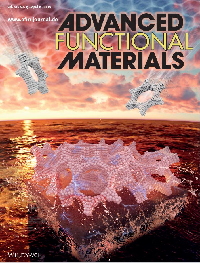
In this work, a versatile method to synthesize mesoporous 3D-IO TiO
2 nanostructures and to incorporate them in photoelectrodes suitable for application in DSSCs has been developed. Their specific surface area and porosity can be strongly increased by adding a small amount of silica precursor during the synthesis and subsequent removal of the formed SiO
2 domains. After removal from the growing substrate the obtained 3D-IO mesoporous nanostructures have been integrated into conventional dye solar cells photoelectrodes while preserving locally their structural properties. These mesoporous layers, containing locally ordered mesoporous 3D-IO nanostructures, have been sensitized with a new organic dye and the resulting solar cells employing iodine-based liquid electrolyte reached a maximum value of 10.35%.
See:
Adv.
Funct. Mater.
2018, 28, 1706291
 Poster award for Asma Medjahed at "Journées Pérovskites Hybrides" in Angers
Poster award for Asma Medjahed at "Journées Pérovskites Hybrides" in Angers 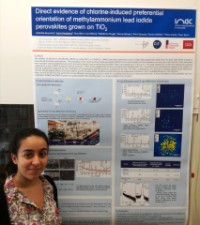
Asma Medjahed from the SyMMES/STEP team was one of the two awardees receiving this year's poster prize at the 3rd French meeting on hybrid perovskites "JPH 2017" taking place in Angers 09/10 May. This meeting, supported by the newly created GDR HPERO (
http://gdr-hpero.cnrs.fr), gathered 120 participants and plenary lectures were given by Prof. Michael Grätzel (EPFL Lausanne), Prof. David Mitzi (Duke University) and Dr. Jacky Even (INSA Rennes). The fourth edition of the meeting will take place in Spring 2018 in the Grenoble area.
 Direct evidence of chlorine-induced preferential crystalline orientation in hybrid perovskites grown on TiO2
Direct evidence of chlorine-induced preferential crystalline orientation in hybrid perovskites grown on TiO2
Synchrotron X-ray diffraction microscopy has been applied to investigate of chlorine in the growth of methylammonium lead iodide perovskite thin films on TiO
2. Our results put into direct evidence that chlorine locates mainly at the TiO
2-perovskite interface and induces the growth of larger crystallites showing preferential orientation along the (110) direction. The effect of chlorine is significantly enhanced on single-crystalline TiO
2 (001) substrates.
See: Bouchard
et al.
J. Phys. Chem. C
2017,
121, 7596-7602
 Metal-free organic sensitizers for DSSCs
Metal-free organic sensitizers for DSSCs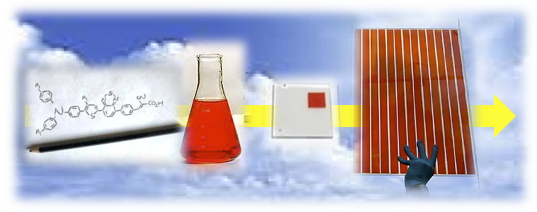
Tremendous progress has been achieved in the past decade in the efficiency of dye-sensitized mesoscopic solar cells (DSSC), owing to the development of new metal-free organic sensitizers. To increase their commercial attractiveness and to make them a realistic approach towards energy markets such as BIPV (building integrated photovoltaics), the new dyes must be cheap, colorful, and efficient, and moreover they must show a high stability. Recently, we have reported a family of donor–acceptor type metal-free photosensitizers with simple structures for DSSCs. The precise molecular design of the dyes leads to a quite narrow light absorption in the visible range and a high photon-to-electrical current conversion in solar cells. These organic sensitizers that can be prepared in few steps show power efficiencies over 10% when they are used with iodine-based liquid electrolytes. Stability tests and fabrication of semitransparent solar modules with an active area of 1400 cm
2 demonstrate the potential of these organic dyes for large scale applications and mass production for BIPV.
See: D. Joly
et al.
Energy Environ. Sci., (2015), 8, 2010
 Jinhyung Park winner of February 2015 NanoART contest
Jinhyung Park winner of February 2015 NanoART contest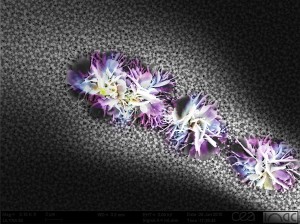
The image "Flowers in the nanogarden" of Jinhyung Park, post-doc at our laboratory, has been selected by the Nanoscience Foundation as the winner of the
February 2015 NanoART contest. It presents a side-product of the synthesis of CuSCN nanostructures, used as p-type electrodes in quantum dot-sensitised solar cells.
 Damien Joly awarded best poster prize at HOPV-14
Damien Joly awarded best poster prize at HOPV-14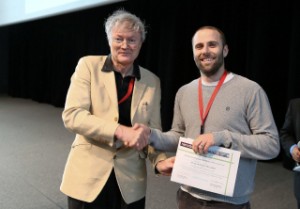
Damien JOLY, post-doc at our laboratory, has been awarded with the best poster prize in the DSSC categories at
HOPV-14 (May 11-14, 2014). This conference was held at Lausanne in Switzerland in May with more than 660 participants. The best poster prize was awarded to Damien by professor Michael Grätzel for his work entitled: "Molecular Engineering of Organic Sensitizers for High Performance Dye-Sensitized Solar Cells"
 New organic dyes
and nanostructured electrodesfor applications in dye sensitized solar cells.
New organic dyes
and nanostructured electrodesfor applications in dye sensitized solar cells.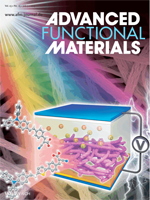
This work presents a new method based on electro-spinning techniques for the preparation of highly porous nanostructured electrodes based on zinc tin oxide (Zn
2SnO
4). Dye sensitized solar cells were fabricated using these electrodes which were sensitized with new purely organic dyes that are developed in our laboratory. The new organic dyes show higher molar absorption coefficients compared to the well-known Ruthenium dye N719. These solar cells are efficient even when using very thin zinc tin oxide layers and a power conversion efficiency of 3.7% has been achieved. This work demonstrates the potential of Zn
2SnO
4 as alternative electrode material to TiO
2 or ZnO for applications in dye sensitized solar cells. It also highlights the significant improvements that can be achieved by replacing the ruthenium-based dyes by purely organic dyes.
 Aurélie Lefrançois awarded L'Oréal-Unesco for women and science fellowship
Aurélie Lefrançois awarded L'Oréal-Unesco for women and science fellowship
Aurélie Lefrançois, PhD student at the laboratory of molecular, organic and hybrid electronics of SPrAM, has been awarded the l'Oréal-Unesco 2012 fellowship for women in science. The award recognizes her work on the synthesis of new semiconductor nanocrystals without toxic metals (copper-indium-disulfide) used to absorb solar light and conduct electrons in solar cells. For several years, the laboratory has been studying organic/inorganic hybrid materials for photovoltaic conversion by thin-film devices, which are flexible and easy to implement. A €15000 scholarship was awarded to A. Lefrançois October 8, 2012, at the Palais de la Découverte.